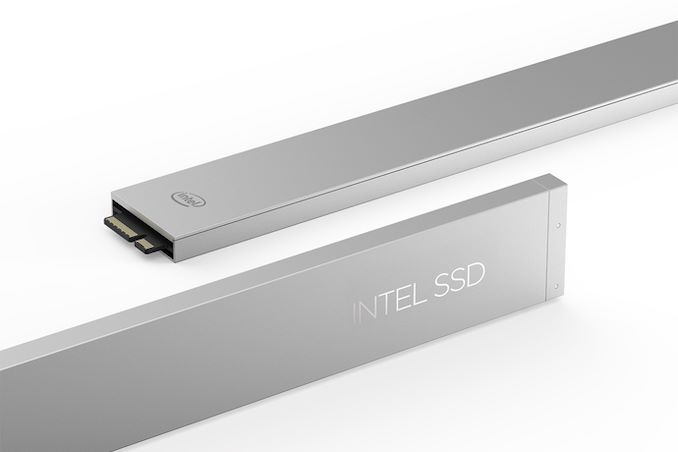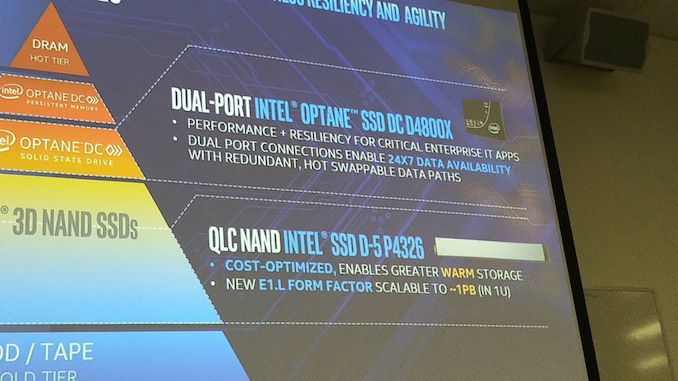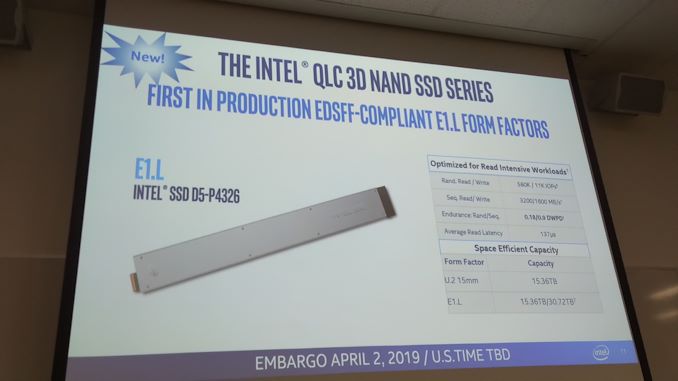Intel Announces New Optane And QLC Enterprise SSDs
by Billy Tallis on April 2, 2019 1:01 PM EST
Slipped in to the briefings for Intel's mountain of announcements today are two new enterprise SSDs at opposite ends of the product line: a new Optane SSD and a new QLC NAND SSD.
Intel Optane SSD DC D4800X
The new Optane SSD DC D4800X differs from the existing P4800X by adding support for dual-port PCIe operation (for high availability) when attached through a PCIe fabric that provides redundant data paths. Most of Intel's NAND-based enterprise NVMe SSDs have dual-port counterparts, but this is the first time this feature has shown up in the Optane product family.
Dual-port support is a relatively niche feature, to the point that many of the current-generation dual-port drives aren't listed on ark.intel.com, and we don't have detailed specifications. Performance will be a bit constrained when using just one of the PCIe 3.0 x2 links, but most of Optane's advantages in latency and random IO throughput will be retained. While the performance-oriented P4800X is available in both U.2 and add-in card form factors, the dual-port capability only makes sense for the hot-swappable U.2 form factor (and potentially EDSFF in the future).
The addition of the dual-port Optane drive indicates that Optane SSDs are reaching a broader audience that now includes mission-critical systems that need high performance but aren't seeking maximum performance to the exclusion of all other factors.
Intel SSD DC D5-P4326
Intel's lineup of enterprise/datacenter SSDs that use four bit per cell QLC NAND flash memory is also expanding. Joining the 7.68TB SSD D5-P4320 announced last fall is the new SSD D5-P4326 with 15.36TB and 30.72TB usable capacities. Intel claims these are the first drives in production that comply with the EDSFF E1.L form factor standard, derived from Intel's earlier "Ruler" concept. The smaller 15.36TB capacity is also available in 2.5" 15mm U.2 form factor. That 15.36TB model was mentioned earlier this year as available for "limited deployments", but Intel is now ready to scale up their efforts.
Compared to Intel's 7.68TB P4320, the larger P4326 drives have improved random read and sequential write performance, while sequential read performance is unchanged and steady-state random write speeds fall significantly to just 11k IOPS. These drives offer the lowest performance and endurance but highest density in Intel's SSD product line: the 30.72TB model allows Intel to reach the goal of 1PB (raw capacity) of flash storage in a 1U server, thanks to the slim EDSFF form factor. Performance per TB is down relative to the smaller P4320, so the P4326 is even less suited for storing hot data, but it still offers a compelling performance advantage over mechanical hard drives, and the write endurance does scale in proportion to capacity: 0.18 drive writes per day for random I/O, and 0.9 DWPD for sequential I/O.
Source: Intel












27 Comments
View All Comments
Greg100 - Wednesday, April 3, 2019 - link
Yes, I found what I want: 7TB+ SSD with 3000MB/s. I just thought, that new QLC from Intel will be cheaper per GB than old TLC from Samsung.Yes there are benefit:
1. Total silence which is important with HDPLEX H5 passive chassis
2. Less heat which is important with HDPLEX H5 passive chassis
3. Less space taken which is important with HDPLEX H5 passive chassis
4. Shock resistant which is important when moving heavy HDPLEX H5 passive chassis
5. Fast editing video files using Adobe Premiere
6. Fast duplicating files using File Explorer
7. Fast checking checksum files using HashCheck (one folder) or SFV Ninja (all folders at once)
8. Fast checking MediaInfo data using PlayTime (all videos at once)
9. Fast Backup
10. Fast and responsive using all other programs, files - so more comfort.
HDDs are only cheaper than SSDs and that’s it.
Failure rate? Backup and frequently checking checksum files with HashCheck or SFV Ninja. I load all checksum files for all my folders in SFV Ninja and with 3000MB/s it is lighting fast - whole disk checked! If something is wrong I have got two more copies of everything.
HStewart - Wednesday, April 3, 2019 - link
I think these drives are intended for large enterprise database servers like SQL Server. For these drives specifically Xeon class machines - Intel only because of chipset requirements.,euler007 - Monday, April 8, 2019 - link
My guess was throwing money and not really needing it. Video, photo, music, a 5400rpm drive would do. smh.abufrejoval - Tuesday, April 2, 2019 - link
I just got myself 4 Samsung 1TB SATA EVOs earlier this year and put them into an Intel software RAID0 to create the 4TB NVME/U.2 I couldn't fit into that machine, because the PCIe slots were alreay max'ed out with an GTX 1060 for Steam streaming, an LSI RAID6 for running the 8x 4TB HDD array and an Aquantia 10Gbit Ethernet card. It's a "desktop" E3 Xeon so 8+4+4 lanes off the CPU and 4 lanes off the PCH is all you get unless you manage to get someone to sell you a motherboard with a PCIe switch, which Avago/Broadcom seems to have priced out of reach to pay for their mergers.And since I cannot see anyone selling M.2 "RAID" adapters with a proper PCIe switch on a budget (or even for real money), I decided to bite the bullet and stick with SATA, where the PCH is essentially a switch, albeit one with a bit of protocol overhead, but lots of maturity and BIOS/OS support.
With the spinning rust hanging off 4 lanes on the CPU side, I get all of the 4 lanes reserved for the PCH to multiplex via SATA among 8 onboard ports, which even 550MB SSDs will saturate before the ports run out.
But even if you're all SSD, using a more modern SAS/SATA RAID[0] controller with a full set of high-capacity SATA SSDs may not be that much worse in terms of performance than a really high-capacity NVMe unit, while you can get a much better deal on capacity/$.
It's not the latency I'd like and NVMe/PCIe switches could provide, but in my case much of the data then goes 10Gbase-T Ethernet, so it's not worth paying top dollar for little practical gain.
Of course it helped that I had 4x and 6x 2.5" SATA enclosures around to fit into the slot where the DVD used to be, because I need the space in the tower to run those 2.5" HDDs in vibe-fixers originally meant for 3,5" drives: No fans required and completely unnoticeable even if they spin and seek.
Just saying that even if U.2 isn't designed for cheap and 8TB NVMe SSDs may not be mainstream enough for a little longer, high capacity SSD can be used for good performance at a relatively flat linear cost scale with SATA and EVO, who also happen to be RELIABLE.
HStewart - Wednesday, April 3, 2019 - link
Are these the same Optane's used in new Dell's that provide 2.7x increase in performance in SQL Server - which I believe treats the database like persistent RAM. I would expect technically if an Application is designed to use would be even more performance. Also noted Samsung is single port transfer rate - these have dual ports and should be twice as fast.I think the Optane drives are in different league than normal SSD's - because of changes required in chipset. Using them as normal SSD is probably under usage.
HStewart - Wednesday, April 3, 2019 - link
Not sure if dual port's could be use in raid 1 like performance - or just used for redundancyIntelUser2000 - Wednesday, April 3, 2019 - link
The slide gives you all that you need to know. Dual ports are for redundancy.Also its the persistent memory version that gives the 2.7x increase. This is the SSD version.